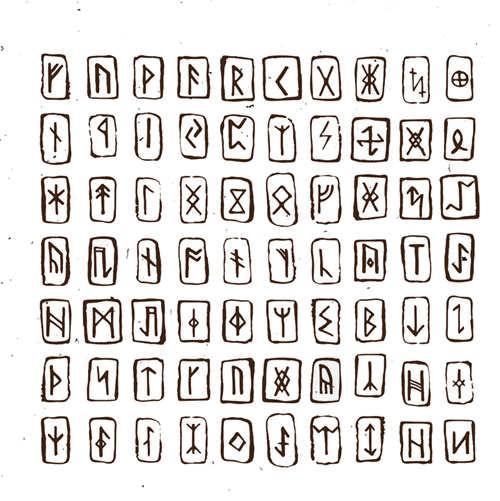Ancient, mystical alphabets
Runes started in 150 A.D. as an alphabet. They were used in Norway, Sweden, Denmark, Germany, and Great Britain until the Latin alphabet took precedence. Odin was said to have brought the runes to earth after he was hung from a tree for nine days. On the last day, he saw the runes and grabbed them, thus ending his torment. The word rune means secret or something hidden. Runes are thought to be magical and were used by people to ward off evil and to divine the future.
There are three different types of rune alphabets. There is the Elder Futhark which was used by Germanic tribes from the 2nd to the 8th centuries. It consisted of 24 runes. These runes were only used by a few elite members of the society. The Kylver stone is an example of the Elder Futhark runes.
The Anglo-Saxon runes were used in Great Britain. They developed from the Elder Futhark. They were used from the 5th to the 9th century when they were supplanted by the Latin alphabet. This rune alphabet consists of 34 different runes.
The Younger Futhark runes, or Scandinavian runes, consist of 16 runes and came into use in the 9th century. The formation of these runes corresponds with the Viking Age. These runes were commonly used in Scandinavia and the Viking settlements. They were used by everyone.
Today, people cast runes to discover what the future will bring. There are twenty-four different runes used for casting. The order in which the runes fall determines the person’s fate. The runes for casting are based on the Elder Futhark. They are:
- Fehu Rune, which means money, material goods, or wealth.
- Uruz Rune, which means strength and virility.
- Thurisaz Rune, which means beginning or gateway.
- Ansuz Rune, which means a message, a signal, or speech.
- Raido Rune, which means travel or movement.
- Kaunaz Rune, which means fire or shedding light on something.
- Gibo Rune, which means a blessing or partnership.
- Wunjo Rune, which means illumination or happiness.
- Hagalaz Rune, which means disillusionment and chaos.
- Nauthiz Rune, which means confinement and pain.
- Isa Rune, which means frustration or inaction.
- Jera Rune, which means fertility and harvest.
- Eihwaz Rune, which means barriers or protection.
- Perth Rune, which means the occult, hidden things, and secrets.
- Algiz Rune, which means protection and defense.
- Sowelu Rune, which means perfection and completion.
- Teiwaz or Tyr Rune, which means conquest or victory.
- Berkana Rune, which means new beginnings or rebirth.
- Ehwaz Rune, which means progression or overcoming barriers.
- Mannaz Rune, which means humanity or the self.
- Leguz Rune, which means motherhood, water, or intuition.
- Inguz Rune, which means beginning or birth.
- Degaz Rune, which means sunlight or entertainment.
- Othela Rune, which means possessions or the home.
Runes can still be found today in parts of Scandinavia on decorations. They are also featured in fantasy literature and video games.

